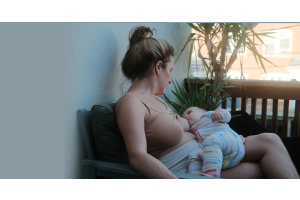Many mums are bothered about the colour of their baby's poop and try to attach meaning to it. Poop color can be one way to keep track of a baby’s health. Their poop colours and textures can drastically change especially during the first year of life. Let's look at the different poop colours that might lead to different growing stages.
Newborn first poop: Meconium
A greenish-black, sticky, tarry substance that looks a lot like motor oil, made up of cells, amniotic fluid, bile, and mucus ingested while in the womb. The colour may look disturbing, but it’s completely normal. Colour should change gradually from black to dark green, then yellow over the first few days by passing out the meconium. Meconium usually does not smell, as it’s sterile.
Breastfed Baby Poop
Breastfed baby poop can vary in color, consistency, and frequency depending on a variety of factors. Here are some common things to expect:
- Color: Breastfed baby poop is typically yellow or mustard-colored. This is because breast milk contains a lot of bilirubin, a yellow pigment that is produced when red blood cells break down.
- Consistency: Breastfed baby poop is usually loose and watery, similar in texture to mustard or cottage cheese. This is normal and indicates the baby is getting enough milk and properly hydrated.
- Frequency: Breastfed babies may poop anywhere from several times a day to once every few days. This variation is normal, as long as the baby is gaining weight and is otherwise healthy.
- Smell: Breastfed baby poop usually has a mild, slightly sweet smell that is not very strong. It is much less pungent than the poop of formula-fed babies.
- Texture: Breastfed baby poop may contain small white or yellow "seeds," which are undigested milk fat globules. This is normal and nothing to worry about.
Overall, breastfed baby poop is generally not a cause for concern as long as the baby is healthy and growing. However, if you notice any changes in color, consistency, frequency, or smell that are not typical for your baby, it's always a good idea to talk to your pediatrician to rule out any potential health issues.
Formula-Fed Baby Poop
Formula-fed baby poop can vary in color, consistency, and frequency depending on a variety of factors. Here are some common things to expect:
- Color: Formula-fed baby poop can range in color from yellow to brown to green. The color may vary depending on the type of formula your baby is drinking and can change as your baby grows.
- Consistency: Formula-fed baby poop is usually firmer than breastfed baby poop, with a more like peanut butter texture. However, the consistency can vary from one baby to another.
- Frequency: Formula-fed babies may poop anywhere from several times a day to once every few days. This variation is normal, as long as the baby is gaining weight and is otherwise healthy.
- Smell: Formula-fed baby poop can have a stronger odor than breastfed baby poop. The smell can vary depending on the type of formula your baby is drinking and can change as your baby grows.
- Texture: Formula-fed baby poop may be more formed and can have small white or yellow "seeds," which are undigested milk fat globules. This is normal and nothing to worry about.
Overall, formula-fed baby poop is generally not a cause for concern as long as the baby is healthy and growing. However, if you notice any changes in color, consistency, frequency, or smell that are not typical for your baby, it's always a good idea to talk to your pediatrician to rule out any potential health issues.
Partially Solid Food-Fed Baby Poop
When a baby begins eating partially solid foods, their poop can change in color, consistency, and frequency. Here are some common things to expect:
- Color: The color of partially solid food-fed baby poop can vary depending on what your baby has eaten. It can be brown, green, or even orange.
- Consistency: Partially solid food-fed baby poop can be thicker than formula or breastfed baby poop. It may be more formed or have small pieces in it.
- Frequency: As your baby begins eating more solid foods, their poop frequency may change. They may poop less frequently than before or more frequently, depending on what they have eaten.
- Smell: The smell of partially solid food-fed baby poop can be stronger than breastfed baby poop, but it is not usually as strong as formula-fed baby poop.
- Smell: The smell of partially solid food-fed baby poop can be stronger than breastfed baby poop, but it is not usually as strong as formula-fed baby poop.
Overall, partially solid food-fed baby poop can vary widely and is usually nothing to be concerned about as long as your baby is healthy and growing. However, if you notice any changes in color, consistency, frequency, or smell that are not typical for your baby, it's always a good idea to talk to your pediatrician to rule out any potential health issues
When should you be concerned and seek medical help?
Here are the alarming signs that you need to know:
- Green Poop
It's common that your baby's poop is slightly greenish, this might occur due to green solid food, even from breastfed mums, it’s not something to worry about if they are putting on weight gradually. But sometimes it also indicates the baby might catch a cold, food allergy or have treatment for jaundice. You should expect to also see other physical symptoms, such as skin problems, tummy upsets, or breathing issues. - Red Poop
Like Green food, It might be because of something they ate or drank, such as tomatoes or fruit punch or digested blood from breastfeeding cracked nipples. However, it might also be a sign of milk protein allergy or baby’s bottom’s bleeding. Always seek professional advice if you have any concerns. - White Poop
This is a big No No for healthy poop. This might mean that the baby has liver disease or is affected by Jaundice. Seek for medical help as soon as possible. - Dry or hard poop
Hard poop can also be a cause of constipation due to improperly digested solid food or baby not drinking enough fluids. - Runny watery Poop
This may result from infection or allergy ort can be an indication of diarrhea. Babies with diarrhea may also poop more often than usual or have a high temperature. - Mucus Poop
Besides meconium, if mucus-textured appears in baby poop, it may be a sign of bacterial infection in your baby’s intestines.
Baby poop color can be one indicator of your baby’s health. if your baby is gaining weight and feeding as often as they need, it’s nothing to worry about. Last but not least, always consult with your pediatrician to confirm your suspicions.












Validate your login
Sign In
Create New Account